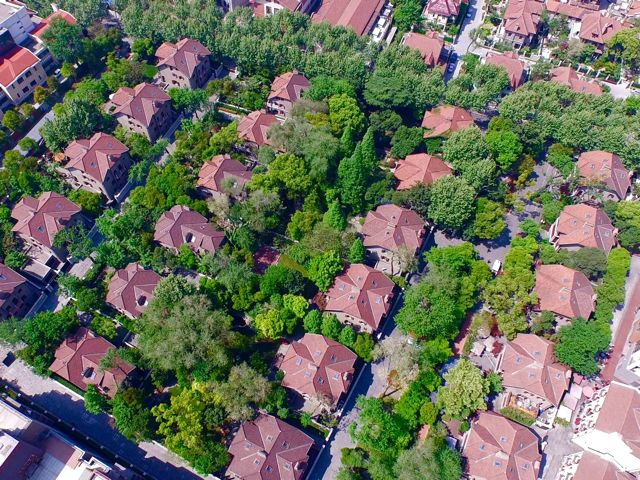Le Corbusier in Shanghai?
 I was recently traveling to the Indian city of Chandigarh and I was very much impressed by what Indian describe as of the most comfortable city in the country.
I was recently traveling to the Indian city of Chandigarh and I was very much impressed by what Indian describe as of the most comfortable city in the country.
At first sight, this statement is not obvious as Chandigarh is a 100% concrete modern city, entirely built by controversial architect Le Corbusier to become the capital of Indian Punjab after Partition. However, compared to other dense traffic and crowded cities of India, one soon realises Chandigarh is a heaven. Traffic is fluid and trees can be seen everywhere. Actually the whole city is designed along the idea of nature, including “green lanes” allowing to cross it (see bellow). The initial project even created a Bureau to manage tree species over 50 years, those having to be higher than the houses.
When wandering deeper in inhabited areas, one is surprised by the calm and “human” environment (third photo). The vision of Le Corbusier was indeed to create seven levels of roads, from avenues to simple paths in order to concentrate car traffic on larger avenues. The result is "sectors" smaller than usual American “blocks”, containing every commodity: cafes, food markets, administrative services…When people mention Le Corbusier, the first image coming to mind is made of concrete and rather tall buildings, a turning point with pre-war architecture. Detractors also refer to the architect's profound love of straight lines and sympathy for facism. Although these facts are real, Chandigarh is far from an inhuman city.
 Le Corbusier vision is one of the city itself as a human body. A city must have a head, a heart and limbs. The other leitmotiv of famous Swiss master is the use human scale as general reference called “Modulor” to measure everything (see first photo).The “head” of Chandigarh is the “administrative forum”. The “heart” is the market area. The limbs consist of large avenues leading to parks or to communication hubs. The choice of an “administrative” head for Chandigarh is linked to the history of the city, founded as a capital as well as Le Corbusier dream the dream of a modern Acropolis. As for the heart, market zone copes with the need of Indian people to secure daily life after Independance. Limbs refer to the idea of communication.
Le Corbusier vision is one of the city itself as a human body. A city must have a head, a heart and limbs. The other leitmotiv of famous Swiss master is the use human scale as general reference called “Modulor” to measure everything (see first photo).The “head” of Chandigarh is the “administrative forum”. The “heart” is the market area. The limbs consist of large avenues leading to parks or to communication hubs. The choice of an “administrative” head for Chandigarh is linked to the history of the city, founded as a capital as well as Le Corbusier dream the dream of a modern Acropolis. As for the heart, market zone copes with the need of Indian people to secure daily life after Independance. Limbs refer to the idea of communication.
What parallel can be drawn with Shanghai?
First of all, I keep referring to Shanghai as a most “human” city, which is contrary to the western idea of a concrete jungle. Indeed, since the 2000 Expo, elevated roads support the larger part of Shanghai car-traffic. Exactly like in a Le Corbusier city, you can walk or bike in Shanghai streets, without meeting cars in many parts of it. This is not of course in the initial project of Shanghai. Shanghainese refer to a noisy and messy city but at least now, we get closer to the vision of Le Corbusier. The other common point between Shanghai and Chandigargh is that both cities where built almost from scratch, enabling modern ideas to influence urban design.
The main illustration of it is the "lilong”, very close indeed to the idea of “sectors” of Le Corbusier. Inside a lilong, almost every commodity can be found too: hairdresser, fresh vegetables, police, laundry, etc… Those were designed to protect the habitants in the first place but it also meant insuring their basic needs of a large number of residents. When you cross a lilong, you definitely are separated from traffic and can have a calm and neighborhood based life. What about the “Shanghai body” then? Actually the Bund was in the 30s, the nevralgic center of Shanghai, mainly based on the idea of business, starting with opium then banking, insurance and real estate activities.
This is characteristic of the “semi-colonial” city design, meant to ensure dominating powers long term and substantial revenues. The “heart” then? It was today’s People Square, initially the Race Course and Entertainment District (see photo above of Race Course surrounded by lilongs in the 40's). A symbol for “Shanghai, gambling hell city”, with its superficial way of life which is still part of Shanghai identity, the “haipai”. The limbs? The Former French Concession with opium smuggling and the Suzhou River, linked to manufacturing activities were two powerful engines of Shanghai wealth during those years. To conclude, when I look at the Former French Concession skyline (above) or newly created green zones, I definitely think Le Corbusier could have designed Shanghai. Villas and 3 storeys houses of the historical Shanghai would probably fit into the “Modulor” idea (see nearby photo in Fuxing Park)
Modernity is meant for people. Shanghai and Chandigarh both stand for strong symbols of it!







/http%3A%2F%2Fstorage.canalblog.com%2F12%2F34%2F1091491%2F106270422_o.jpg)
/https%3A%2F%2Fstorage.canalblog.com%2F37%2F01%2F1091491%2F122760146_o.jpeg)
/https%3A%2F%2Fstorage.canalblog.com%2F80%2F93%2F1091491%2F122869425_o.jpeg)
/https%3A%2F%2Fstorage.canalblog.com%2F54%2F68%2F1091491%2F122760097_o.jpeg)
/https%3A%2F%2Fprofilepics.canalblog.com%2Fprofilepics%2F1%2F0%2F1001591.jpg)